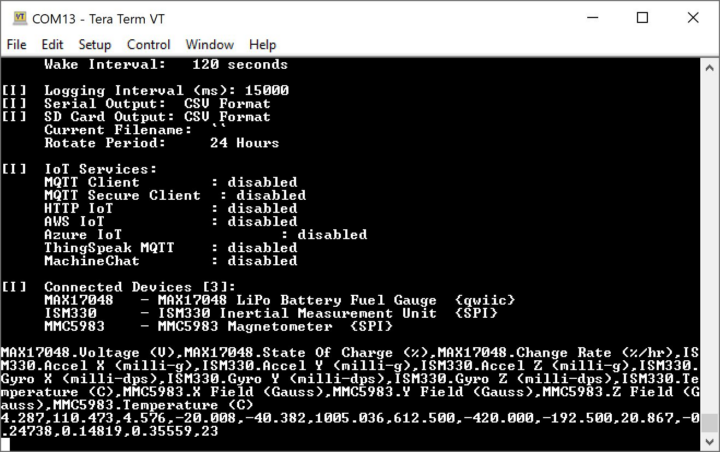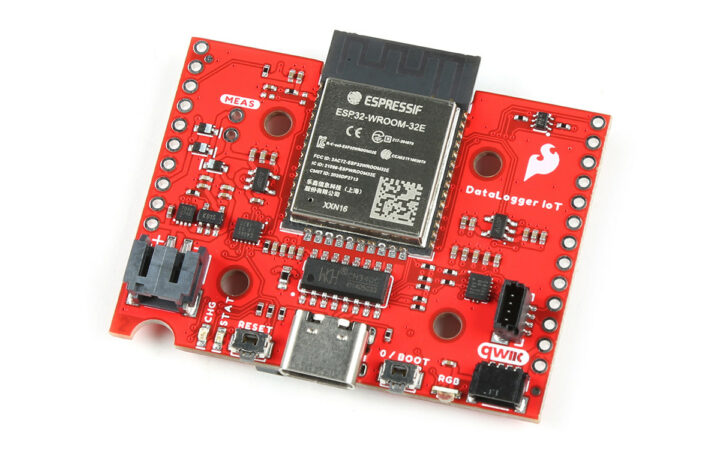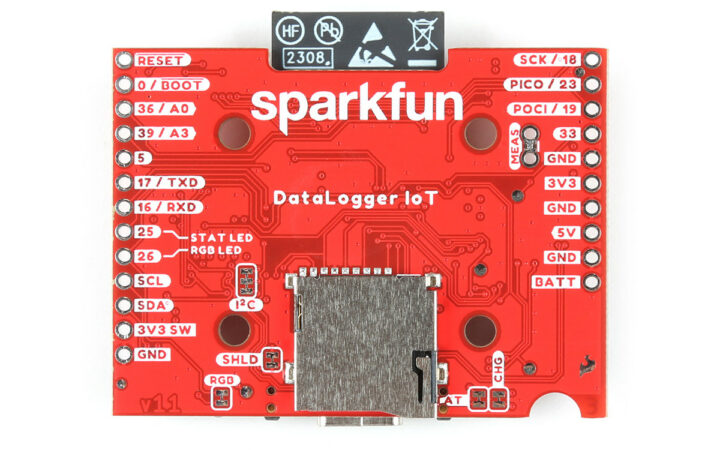Last May, SparkFun introduced the “Datalogger IoT – 9DoF” no-code platform with support for over 50 Qwiic sensor modules and a built-in 9-axis IMU sensor and magnetometer.
Taking into consideration that some users may not make use of the built-in sensors, the company decided to launch a cheaper version called the “DataLogger IoT” that can still get data from Qwiic sensor and GPS modules without any programming thanks to the “no-code” Arduino firmware preloaded on the ESP32-WROOM-32E module.
SparkFun DataLogger IoT specifications:
- Wireless module – ESP32-WROOM-32E with:
- ESP32 dual-core microcontroller
- 4MB flash
- 2.4 GHz WiFi and Bluetooth LE connectivity, built-in PCB antenna
- Storage – MicroSD card slot
- USB – 1x USB Type-C port for power and configuration via CH340C
- Expansion – 2x Qwicc I2C connectors for sensors and/or GPS module
- Misc
- Boot and Reset buttons
- Status and charging LED, WS2812 RGB LED
- Jumpers to enable/disable LEDs, I2C pull-up resistors, and USB shield
- Power Supply
- 3.3V to 6.0V via VIN
- 5V via USB Type-C port
- 3.6V to 4.2V via 2-pin JST connector or VBAT pin for a LiPo battery
- Built-in MCP73831 single-cell LiPo charger with at least 500mA charge rate
- MAX17048 LiPo fuel gauge
- Dimensions – About 5.1 x 4.2 cm
- Weight – 10.65 grams
The lower-cost DataLogger IoT board still uses the same datalogger firmware which allows the user to configure the board through a serial terminal without any programming (e.g. to set CSV/JSON data format, set the logging interval, configure MQTT, etc.), and since it relies on Qwiic modules, soldering is not needed either.
Supported Qwiic modules include u-Blox GNSS modules, proximity and ToF distance sensors, various pressure, altitude, humidity, and temperature modules, an RTC module, a weighing module, an NFC/RFID module, ADC modules, as well as air quality and environmental sensors.

Removing the ISM330DHCX 6-axis IMU accelerometer & gyroscope and the MMC5983MA magnetometer makes the board $20 cheaper with the Sparkfun DataLogger IoT going for $54.95 plus shipping. Since it does not come with any sensors at all, you’ll also need some Qwiic modules if you don’t have any already. Further details may also be found in the announcement.

Jean-Luc started CNX Software in 2010 as a part-time endeavor, before quitting his job as a software engineering manager, and starting to write daily news, and reviews full time later in 2011.
Support CNX Software! Donate via cryptocurrencies, become a Patron on Patreon, or purchase goods on Amazon or Aliexpress. We also use affiliate links in articles to earn commissions if you make a purchase after clicking on those links.







It doesn’t have an RTC.. so you’re going to log stuff without time stamps? I can’t see that being useful in 90% of usecases
Have the accelerometer & gyroscope built into the logger itself was a very strange choice for the original version – that said, while this is better it’s still way way too expensive. It needs an RTC and be 15-20 bucks
power draw is also unclear – if you’re logging to an SD card then that’s usually not where you need a Wifi chip. I’d use a smaller more power efficient chip
If a timestamp is important, why not choose the version with GPS?
GPS should provide a better clock then RTC ever could.
I’m not sure how thatd even work.. you have the GPS module continiously powered? Or each time you log something you’re going to reaquire a GPS signal?
Often you can’t always ensure you have a GPS signal – and relatively speaking that sounds like a much more power hungry option. You’re generally not running a logger in a location where you have easy access to power (otherwise you’d just run a RPi/SOM board – which is cheaper and easier to use than this)
https://www.sparkfun.com/products/16281
I’ve been trying to do affordable long term rain gauge logging (for research). It’s surprisingly hard to just get something really basic that’s waterproof that would take the time a circuit is closed and write it to an SD Card. Working with a friend we eventually designed our own boards/enclosures – but we don’t have the advantage of manufacturing scale. We got down to a 20-30 dollars range, but it’s very clear this stuff could be much cheaper
https://github.com/SWPhantom/Rainus
(we use an ESP32 C3/Arduino for simplicity)
But do you have a json-configurable firmware? Hardware is cheap, no-code firmware in an existing ecosystem is not.
If they added a 4g module, this could be used by (almost) anyone and it would “just work”, especially if they’d add an automatic PAN, so the nodes works connect to the internet through a gateway. Many companies would jump over it as no-code will be a lot faster ttm and cheaper (up until thousands of nodes). For a one-off PoC this is great!
Two serial lorts would help. Another for uploading the code and another for devices. Even a mechanical switch here would help.
SD slot is nice to have in many projects. Holes for LED:s are sometimes valuable. In some cases they are a PITA.
$55 ? There must be a typo.
Not needed, because you are supposed to do ota upstate